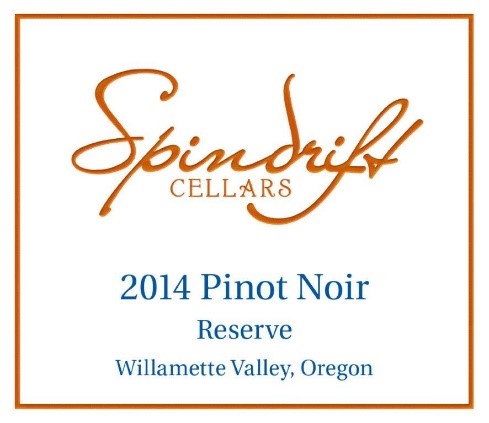Pinot Noir Reserve, Spindrift
Appellation: Willamette Valley AVA
Type: Red
Grape Varietals: Pinot Noir
2014 Spindrift Cellars Pinot Noir Reserve has wonderful length and elegance. Silky aromas of red fruit and toasty oak along with earthy under tones. Full but elegant palate of berry and oak with balanced acidity.
Region: Willamette Valley, Oregon
Color: Rich ruby red
Bouquet: high aromas of red fruit, cherry, earthy and toasty notes
Flavor: Big cherry flavors with some oak, sweet tannins, bright acidity and lingering finish. The fragrant mix of flowers and fruit introduces the wine. Centering on plum, currant fruit, lifted by balanced acidity. Finishes with a silky texture and a good lingering finish
Serving suggestions: Best served between 55-60° Fahrenheit.
Food Pairings: Smokey glazed ham, easy lentil curry, garlic and herb roasted tenderloin, duck with a citrus glaze, salmon filets and mushrooms roasted
Three old vine vineyards make up with Pinot Noir small vineyards located in the heart of the Willamette Valley. Many of the vineyards are over 15 years old and all dry farmed. Pinot Noir clones include: Pommard and Wädenswil. The vineyards average about 2.25 tons per acre. Deerhaven Vineyard (planted in 1997), Woodhall Vineyard (planted in 1978) & Mary’s Peak (planted in 1978)
Vineyard: Ten small vineyards located in the heart of the Willamette Valley and all are dry farmed. Pinot Noir clones include: Pommard, Wädenswil, 115, 777 and 667.
Yield: The vineyards average about 2.25 tons per acre.
Soil: Clayey, smectitic, mesic, mostly Philomath silty clay
Viticulture: Many of the vineyards are over 15 years old
Vinification: Each vineyard produced separately in small 1.5 ton fermenters with the use of manual punch downs of the caps two times a day during fermentation
Aging Process: The wines from each vineyard after fermentation were then stored in French oak barrels for a number of months before being blended and bottled
Note: Wines were bottled in Screwcap Closures to retain its great fruit flavors and aromas.


